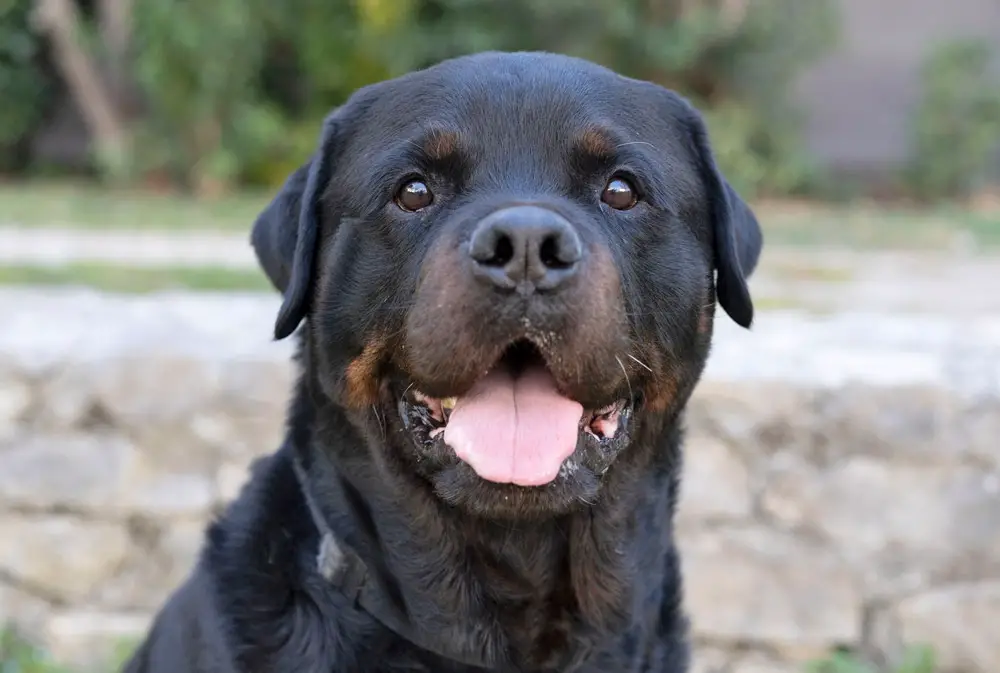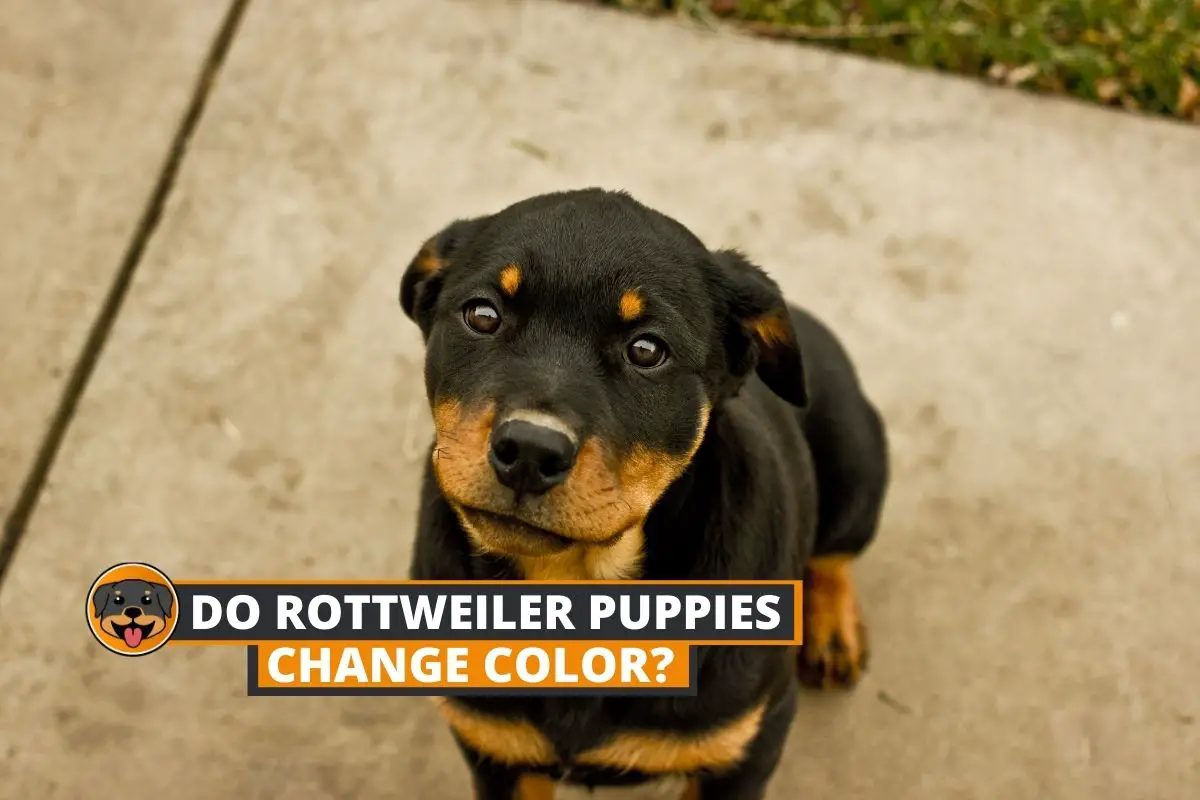You might have to stumble upon an old photo of your rottweiler in which it has a different color. So do Rottweiler change color?
Rottweiler puppies change the color of their coat as they grow. The color of the puppies’ coats can turn darker or lighter in their adulthood. This change is very much normal and expected.
Further in this article, we will go through Rottweiler’s standard color and explain the possible reasons for color changes.
Standard colors of Rottweiler
Based on the AKC standard, the Rottweiler’s coat should be black with rust to mahogany markings. The distinction between black and rust is to be clearly defined. The quantity and location of markings are essential and should not exceed ten percent of body color.
Generally speaking, there are three accepted coat color combinations for Rottweilers:
- Black and mahogany
- Black and rust
- Black and tan
Color Changes that are Normal in Rottweilers
In Rottweilers, some coat color changes are normal and expected.
Maturity
As the root puppies grow, the color of their coat either become darker or lighter. As the puppies grow, their body goes through a color pigmentation which changes the color of their hair.
You can discover the actual color of a rottweiler only in their adulthood.
Old age
Just like an older person, a senior Rottweiler will eventually develop grey or white hair. This is because, over time, the hairs lose their pigment. Once the pigment is lost, the color is lost too, and the hair remains naturally colorless, or simply put – white.
Cyclic alopecia
Cyclic alopecia is a regular and seasonal change every dog goes through, and Rottweilers are no exception. Cyclic alopecia follows the natural shedding cycle, and therefore, it is not considered a condition.
However, it can be a bit distressing as the Rottweiler’s hair will stop growing, hairless patches will develop, and the hair that remains will become significantly darker. Cyclic alopecia is a self-limiting change, and the hair retrieves its standard color in a few weeks.
Color changes and health conditions
Several health conditions are linked with coat color changes. Let’s have a look at a few of them:
Color dilution
As mentioned, color dilution is a rare inherited condition that manifests with diluted or light primary colors. In Rottweiler’s case, the dilution results in a grey-colored coat.
If both parents carry the dilute gene, the puppy will inherit it, but it will not manifest the defect immediately after birth. Namely, the Rottweiler puppy’s coat will turn grey when eight to ten months old.
Albinism
Albinism is a highly infrequent genetic mutation scientifically termed as tyrosinase (when the dog is fully albino) or tyrosinase positive (when the dog is partially albino).
Albino dogs are white because they lack the genes responsible for melanin production.
An albino Rottweiler requires special care and is at higher risk for many health conditions, including light sensitivity and eye abnormalities.
Vitiligo
Vitiligo is a dermatological issue that occurs when the skin loses its natural pigment. It is not determined what causes the pigment loss, but it is suggested that there is a genetic component.
When the skin loses its pigment and turns white or light pink, the hair coming out of the pigment-lacking spots turns white.
There is no cure or reversal technique for vitiligo. On the bright side, it is a painless, benign, and purely cosmetic issue.
Cushing’s disease
Cushing’s disease is the medical term for a hyperactive adrenal gland. The condition manifests with an array of clinical signs and symptoms. Color changes and intense hair falling are among them. Cushing’s disease is a severe and potentially life-threatening condition that requires veterinary management.
The ‘Rare’ Rottweiler colors

It is undeniable that the rare colors are striking. However, they are not desirable as they result from genetic defects that are also responsible for other anomalies. The coat color is a cosmetic issue, but some of the associated defects can be severe and decrease the Rottweiler’s quality of life.
The White Rottweiler
The most common reasons why a Rottweiler will be white are albinism and vitiligo, which are both skin problems.
A Rottweiler with albinism will lack pigment all over its body and be entirely white. Albinism is a genetic defect which means Rottweilers are born with it.
On the other hand, a Rottweiler with vitiligo will have irregularly distributed white patches and standard, black and tan patches between the white.
Finally, a Rottweiler may turn white if it is a crossbreed. Naturally, white Rottweilers do not exist. Sadly, irresponsible breeders often sell white Rottweiler crossbreeds by labeling them as ‘rare.’
The Grey Rottweiler
Like the ‘rare white Rottweiler,’ the grey version is also rare and likely to occur due to crossbreeding.
A purebred Rottweiler can be born grey if it inherits the dilute gene from both parents. The dilute gene is recessive and particularly rare. On its own, this gene’s inheritance is not problematic. However, the fact that the breeder bred two grey Rottweilers questions its reputation.
Some breeders label grey Rottweilers as ‘blue,’ thus proving their unfamiliarity with the breed.
The Black Rottweiler
The all-black Rottweiler is not considered a regular color variety. If a Rottweiler is born entirely black with no markings at all, it is a crossbreed.
However, Rottweilers can be born with extremely small or vaguely pronounced markings. This color alternative is not considered a defect but is particularly rare as most breeders favor rich and accented markings.
The Red Rottweiler
Red Rottweilers do not occur as a result of faulty genes. They are always a result of crossbreeding.
Is the color that important?
At first, it may seem shallow and vane to choose a dog based on its color. However, when it comes to the coat color, there is more than a simple esthetic component. Namely, if you want to include your Rottweiler in shows and competitions, the lack of standard color and pattern is a disqualification concern.
Even if you got the Rottweiler solely as a pet and are not interested in shows and competitions, the color variations are still concerning. That is because they are almost always linked with other defects and health issues.
Final Thoughts
In Rottweilers, some color changes develop later in life as a result of diseases or medical conditions. These color changes cannot be predicted and are, therefore, hard to prevent. On the other hand, the color changes labeled as ‘rare’ are a sign of irresponsible breeding and should be avoided at all costs.
Make sure to buy your Rottweiler from a reputable breeder who can assure you that the rottweiler is purebred. You can read this guide to identify a purebred rottweiler. Later on, if its color changes, love it anyway and help it overcome the condition that triggered the color change.





